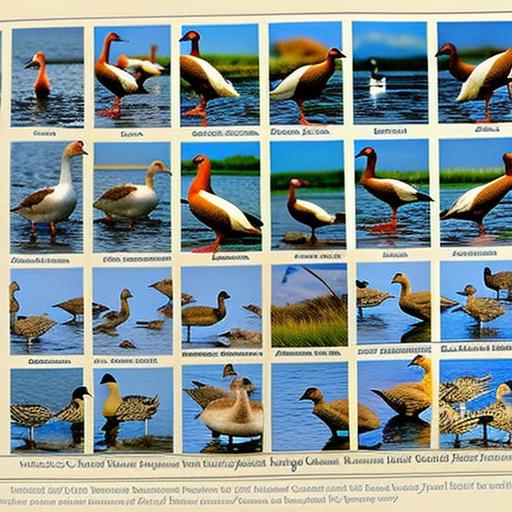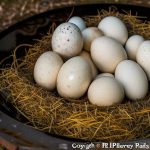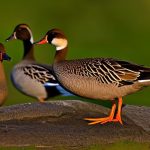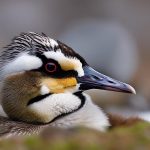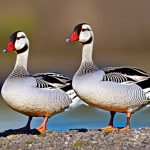Breeding geese and waterfowl is a popular practice among farmers and hobbyists alike. Geese and waterfowl, such as ducks and swans, are known for their beauty, grace, and usefulness on a farm. They can provide a source of income through the sale of breeding stock, eggs, and meat, as well as contribute to the overall ecosystem of a farm.
Breeding geese and waterfowl is important for several reasons. Firstly, it allows for the preservation of rare and endangered breeds. Many breeds of geese and waterfowl are at risk of extinction due to habitat loss and human activity. By breeding these birds, farmers can help ensure their survival for future generations. Additionally, breeding geese and waterfowl can provide a sustainable source of food for the farm. The eggs and meat produced by these birds are highly nutritious and can be a valuable addition to a farm’s product offerings.
Raising geese and waterfowl on a farm also has numerous benefits. These birds are excellent foragers and can help control pests such as insects and weeds. They also produce high-quality manure that can be used as fertilizer for crops. Furthermore, geese and waterfowl are relatively low-maintenance animals compared to other livestock, making them an attractive option for farmers with limited time or resources.
Key Takeaways
- Breeding geese and waterfowl requires knowledge of their anatomy and physiology
- Selecting the right breeds for your farm is crucial for successful breeding
- Creating an ideal environment for breeding involves proper housing and nesting areas
- Feeding and nutrition play a key role in the health and productivity of breeding stock
- Effective breeding techniques and strategies can lead to optimal results in hatching and raising goslings and ducklings.
Understanding the Anatomy and Physiology of Geese and Waterfowl
To successfully breed geese and waterfowl, it is important to have a basic understanding of their anatomy and physiology. Geese and waterfowl have unique adaptations that allow them to thrive in aquatic environments.
The basic anatomy of geese and waterfowl includes features such as webbed feet, waterproof feathers, and specialized bills for filter-feeding or grazing. These adaptations enable them to swim, dive, and feed in water bodies. Geese and waterfowl also have a highly efficient respiratory system that allows them to extract oxygen from the air and water.
The reproductive system of geese and waterfowl is also unique. Female geese and waterfowl have a single ovary and oviduct, while males have a pair of testes. During the breeding season, females will lay eggs that are fertilized by males. The eggs are then incubated until they hatch into goslings or ducklings.
Understanding the breeding cycle of geese and waterfowl is crucial for successful breeding. The breeding season typically occurs in the spring, when daylight hours increase and temperatures rise. During this time, males will engage in courtship displays to attract females. Once a pair has formed, they will mate and the female will lay eggs. The eggs are then incubated for a specific period of time until they hatch.
Selecting the Right Breeds for Your Farm
When it comes to breeding geese and waterfowl, selecting the right breeds is essential. There are several factors to consider when choosing breeds for your farm.
One important factor to consider is the purpose of breeding. Are you looking to raise geese and waterfowl for meat, eggs, or as ornamental birds? Different breeds have different characteristics that make them more suitable for certain purposes. For example, some breeds are known for their meat production, while others are prized for their egg-laying abilities or unique plumage.
Popular breeds for breeding geese include Toulouse, Embden, and Chinese geese. Toulouse geese are known for their large size and excellent meat quality. Embden geese are also large and are often raised for meat production. Chinese geese are smaller in size but are known for their excellent egg-laying abilities.
For breeding waterfowl, popular breeds include Pekin ducks, Muscovy ducks, and Mallards. Pekin ducks are the most common breed of domestic duck and are known for their fast growth and high meat yield. Muscovy ducks are unique in that they are not true ducks but rather a separate species. They are known for their lean meat and ability to control pests. Mallards are a wild species of duck that can also be raised on a farm. They are prized for their beauty and adaptability.
When selecting breeds for your farm, it is important to consider the climate and environment in which they will be raised. Some breeds are better suited to cold climates, while others thrive in warmer conditions. It is also important to consider the availability of breeds in your area and any local regulations or restrictions on breeding certain species.
Creating the Ideal Environment for Breeding
Creating the ideal environment for breeding geese and waterfowl is crucial for their health and reproductive success. Geese and waterfowl have specific housing requirements, temperature and lighting needs, as well as nesting and breeding areas.
Geese and waterfowl require adequate housing to protect them from predators, extreme weather conditions, and disease. The housing should be spacious enough to allow the birds to move around freely and have access to fresh air and sunlight. It should also be well-ventilated to prevent the buildup of ammonia from their droppings.
Temperature and lighting requirements vary depending on the breed and stage of breeding. Geese and waterfowl generally prefer cooler temperatures, but some breeds can tolerate warmer conditions. It is important to provide shade or cooling mechanisms during hot weather to prevent heat stress. Lighting is also important for breeding success, as it helps regulate the birds’ reproductive cycles. Providing artificial lighting during the winter months can stimulate breeding behavior.
Nesting and breeding areas should be provided to encourage natural mating behaviors. Geese and waterfowl prefer secluded areas with soft bedding materials such as straw or grass. Nest boxes or platforms can be provided to encourage nesting and egg-laying. It is important to regularly clean and disinfect nesting areas to prevent the spread of disease.
Feeding and Nutrition for Breeding Geese and Waterfowl
Proper feeding and nutrition are essential for breeding geese and waterfowl. These birds have specific nutritional requirements that must be met in order to ensure optimal breeding results.
Breeding geese and waterfowl require a balanced diet that includes a combination of grains, greens, protein, and vitamins and minerals. Commercially available waterfowl feeds can provide a good base diet, but it is important to supplement with fresh foods such as grass, weeds, and vegetables. Greens are especially important for geese and waterfowl, as they provide essential nutrients and help maintain digestive health.
Feeding strategies for breeding geese and waterfowl can vary depending on the stage of breeding. During the breeding season, it is important to provide a higher protein diet to support egg production and fertility. This can be achieved by offering a higher percentage of protein-rich feeds or by supplementing with additional protein sources such as mealworms or fish meal.
It is also important to provide access to clean, fresh water at all times. Geese and waterfowl require water for digestion, cooling, and bathing. Water should be changed regularly to prevent contamination and the spread of disease.
Common feeding mistakes to avoid include overfeeding or underfeeding, feeding low-quality or spoiled food, and providing an unbalanced diet. Overfeeding can lead to obesity and related health issues, while underfeeding can result in poor reproductive performance. Feeding low-quality or spoiled food can lead to nutrient deficiencies or the spread of disease. It is important to monitor the birds’ body condition and adjust feeding amounts accordingly.
Breeding Techniques and Strategies for Optimal Results
Breeding geese and waterfowl can be achieved through natural breeding or artificial insemination. Natural breeding is the most common method and involves allowing the birds to mate naturally. Artificial insemination is a more advanced technique that involves manually collecting and inseminating semen.
The breeding season and frequency can vary depending on the breed and environmental conditions. Geese and waterfowl typically breed in the spring, when daylight hours increase and temperatures rise. During this time, males will engage in courtship displays to attract females. Once a pair has formed, they will mate and the female will lay eggs. The eggs are then incubated for a specific period of time until they hatch.
Tips for successful breeding include providing adequate nesting areas, ensuring proper nutrition, and monitoring the birds’ behavior and health. It is important to observe the birds for signs of mating behavior, such as courtship displays or copulation. Regularly checking nesting areas for eggs and monitoring egg production can also help ensure successful breeding.
Health and Disease Management for Breeding Stock
Maintaining the health of breeding geese and waterfowl is crucial for their reproductive success. Common health issues in breeding geese and waterfowl include respiratory infections, parasites, egg-binding, and nutritional deficiencies.
Preventative measures for disease management include regular vaccinations, proper nutrition, good hygiene practices, and regular health checks. Vaccinations can help protect against common diseases such as avian influenza or duck viral enteritis. Providing a balanced diet that meets the birds’ nutritional requirements can help boost their immune system and prevent nutrient deficiencies.
Good hygiene practices such as regular cleaning and disinfection of housing areas, nesting areas, and feeding equipment can help prevent the spread of disease. It is also important to quarantine new birds before introducing them to the existing flock to prevent the introduction of diseases.
Treatment options for sick birds can vary depending on the specific illness or condition. It is important to consult with a veterinarian for proper diagnosis and treatment. Common treatment options include antibiotics, antiparasitic medications, and supportive care such as providing a warm and clean environment.
Incubation and Hatching of Eggs
Incubation and hatching of eggs is a critical stage in the breeding process. Proper incubation conditions are essential for the development and hatching of healthy goslings and ducklings.
Incubation requirements for geese and waterfowl eggs include temperature, humidity, and turning. The optimal temperature for incubating most waterfowl eggs is around 99-101 degrees Fahrenheit (37-38 degrees Celsius). Humidity levels should be maintained at around 55-60% for the first 25 days, then increased to 70% for the final days of incubation. Turning the eggs several times a day is important to prevent the embryos from sticking to the shell and promote even development.
The hatching process typically takes around 28-35 days, depending on the breed. During this time, the embryos will develop and eventually break through the shell to emerge as goslings or ducklings. It is important to provide a quiet and undisturbed environment during hatching to minimize stress on the chicks.
Common hatching problems include infertility, early embryonic death, and malpositioned or stuck embryos. Infertility can be caused by factors such as poor nutrition, age of the birds, or genetic issues. Early embryonic death can occur due to improper incubation conditions or genetic abnormalities. Malpositioned or stuck embryos can be caused by improper turning or inadequate humidity levels. It is important to monitor the incubation process closely and make adjustments as needed.
Raising Goslings and Ducklings
Once goslings and ducklings have hatched, they require special care and attention to ensure their health and well-being. Care requirements for newly hatched goslings and ducklings include feeding, watering, housing, and environmental needs.
Feeding and watering requirements for goslings and ducklings are similar. They should be provided with a balanced diet that meets their nutritional needs. Commercially available waterfowl starter feeds can provide a good base diet, but it is important to supplement with fresh foods such as greens, insects, and small fish. Fresh, clean water should be provided at all times.
Housing and environmental needs for goslings and ducklings include a warm and clean environment with adequate space to move around. Brooder boxes or pens can be used to provide a safe and secure space for the young birds. The temperature should be maintained at around 90-95 degrees Fahrenheit (32-35 degrees Celsius) for the first week, then gradually reduced by 5 degrees each week until they are fully feathered.
Marketing and Selling Your Breeding Stock and Products
Once you have successfully bred geese and waterfowl, you may be interested in marketing and selling your breeding stock and products. Finding a market for your breeding stock and products can be done through various channels such as local farmers’ markets, online platforms, or direct sales to other farmers or hobbyists.
When pricing your breeding stock and products, it is important to consider factors such as the breed, quality, age, and demand. Rare or high-quality breeds may command a higher price, while older birds or those with health issues may be sold at a lower price. It is also important to consider the costs associated with raising the birds, such as feed, housing, and veterinary care.
Tips for successful marketing and sales include promoting the unique qualities of your breeding stock or products, providing excellent customer service, and building relationships with potential buyers. It can also be helpful to network with other farmers or join local poultry associations to gain exposure and access to potential customers.
In conclusion, breeding geese and waterfowl can be a rewarding and profitable venture for farmers and hobbyists. By understanding the anatomy and physiology of these birds, selecting the right breeds, creating the ideal environment, providing proper nutrition, implementing effective breeding techniques, managing health and disease, incubating and hatching eggs, and raising goslings and ducklings, you can achieve optimal breeding results. With proper marketing and sales strategies, you can also find a market for your breeding stock and products. Breeding geese and waterfowl not only provides a source of income but also contributes to the overall ecosystem of a farm. So why not start breeding geese and waterfowl today?
If you’re interested in breeding geese and waterfowl, you may also find this article on poultrywizard.com helpful. It provides valuable insights into the best practices for keeping chickens and building a chicken coop. From choosing the right coop design for your chickens to exploring interior ideas that promote their well-being, this article covers it all. Check it out here to enhance your knowledge on creating a suitable environment for your feathered friends.
FAQs
What is the purpose of books on breeding geese and waterfowl?
Books on breeding geese and waterfowl serve as a guide for individuals who are interested in raising and breeding these birds. They provide information on the different breeds, their characteristics, and the best practices for breeding and caring for them.
What topics are covered in books on breeding geese and waterfowl?
Books on breeding geese and waterfowl cover a wide range of topics, including the different breeds of geese and waterfowl, their characteristics, breeding techniques, incubation and hatching, feeding and nutrition, housing and management, and health and disease management.
Who can benefit from reading books on breeding geese and waterfowl?
Anyone who is interested in raising and breeding geese and waterfowl can benefit from reading books on the subject. This includes hobbyists, farmers, and commercial breeders.
Are there any specific breeds of geese and waterfowl that are covered in these books?
Yes, books on breeding geese and waterfowl cover a wide range of breeds, including but not limited to Toulouse, Embden, African, Chinese, and Pilgrim geese, as well as Muscovy and Pekin ducks.
Where can I find books on breeding geese and waterfowl?
Books on breeding geese and waterfowl can be found at most bookstores, as well as online retailers such as Amazon and Barnes & Noble. They may also be available at agricultural supply stores and through breeders’ associations.
Meet Walter, the feathered-friend fanatic of Florida! Nestled in the sunshine state, Walter struts through life with his feathered companions, clucking his way to happiness. With a coop that’s fancier than a five-star hotel, he’s the Don Juan of the chicken world. When he’s not teaching his hens to do the cha-cha, you’ll find him in a heated debate with his prized rooster, Sir Clucks-a-Lot. Walter’s poultry passion is no yolk; he’s the sunny-side-up guy you never knew you needed in your flock of friends!

